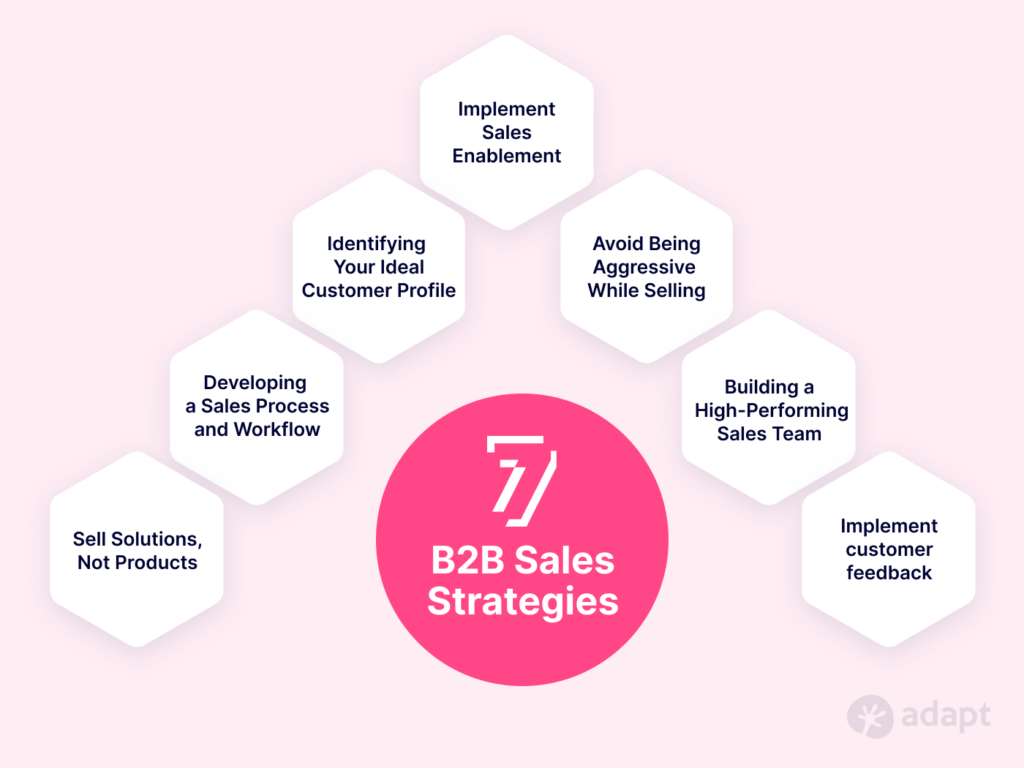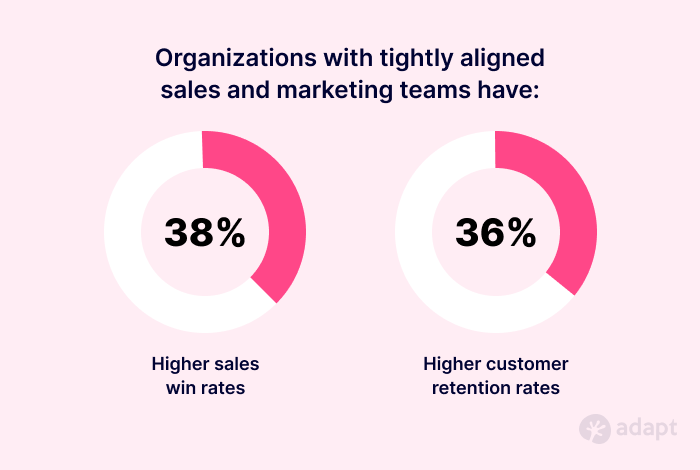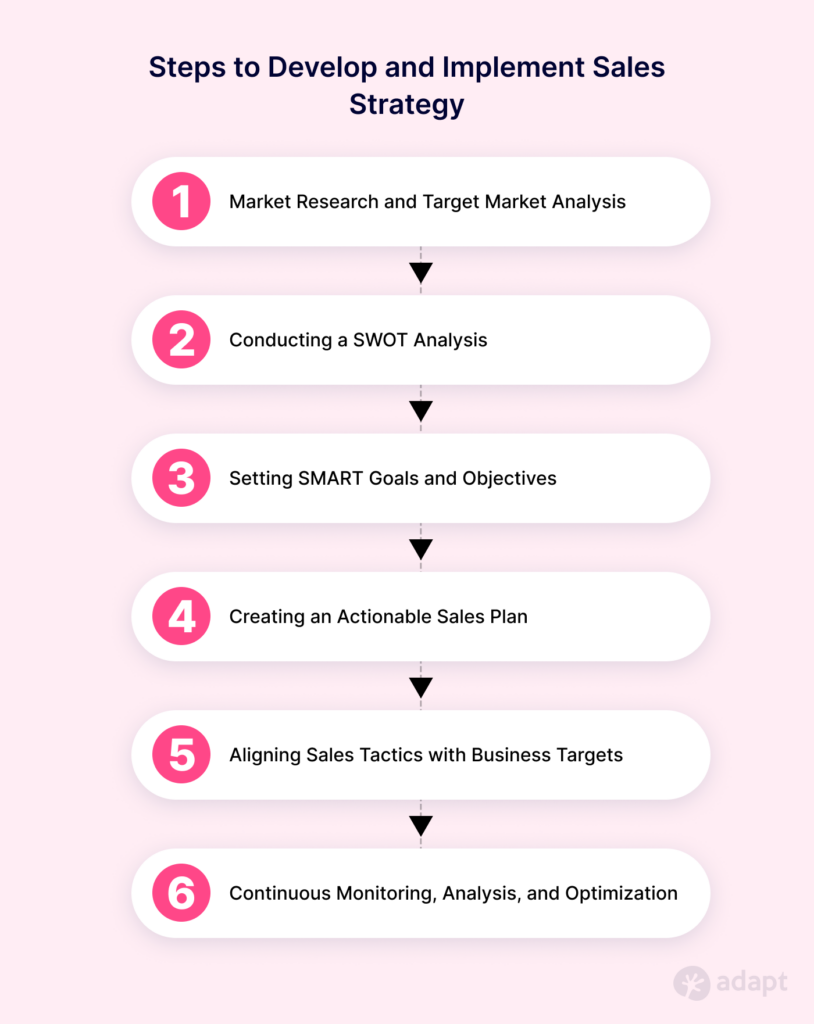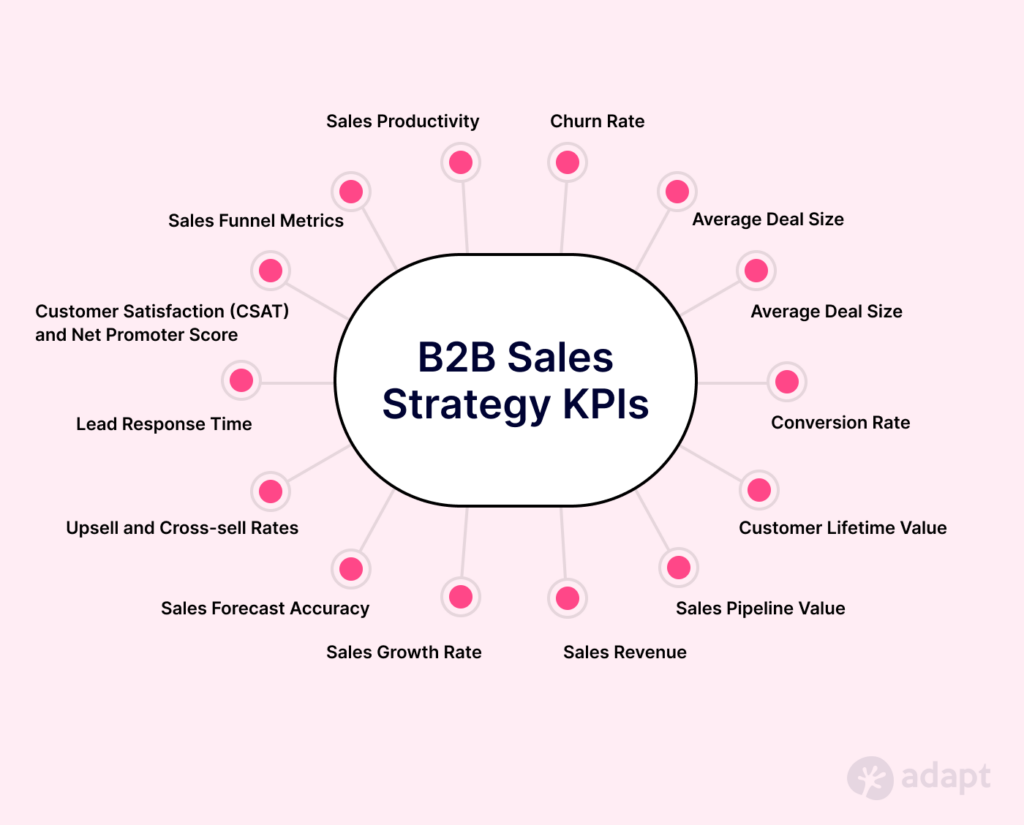Posted June 23, 2023
An effective B2B sales strategy is essential for steady revenue growth. It lets teams build meaningful customer relationships while staying focused on conversions. Such roadmaps also enable companies to assess and avoid risks and secure revenue.
According to reports, a staggering 72% of sales professionals do not anticipate meeting their annual quotas. One of the primary factors contributing to this is the absence of a clear direction in lead qualification and nurturing. By implementing a well-defined sales strategy, organizations provide their sales representatives with a goal-oriented and data-driven pathway to close more deals. However, perfecting a sales strategy is a gradual process that demands continuous refinement.
To simplify this journey, we’ve assembled a comprehensive guide that delves into various sales methodologies, their core components, and the best practices to attain targets and expedite revenue growth.
What is B2B Sales Strategy?
A B2B sales strategy can be defined as a detailed plan to help your sales team to position your products to qualified buyers and make your brand stand out among the competitors. It offers clear goals and direction to the sales team for better conversions.
An effective sales strategy is your sales rep’s guide to establishing a meaningful connection with prospects. It tells them how to approach a particular problem and position your product as its best solution. This improves your sales team’s performance and keeps them focused on business objectives.
Having a clear sales strategy also helps in 4 major ways:
- Enable companies to assess risks and eliminate them early on
- Improve customer experience by providing accurate customer data
- Simplify resource allocation and optimize results
- Qualify leads and nurture them with better personalization
Discover the Sales Execution Platform
See how Outreach helps sellers close over 2 million opportunities.
How To Leverage Both Inbound and Outbound Sales Strategies Together?
To harness the full potential of lead generation, it’s essential to seamlessly merge inbound sales and outbound sales strategies. Start by understanding your target audience and creating buyer personas. On the inbound front, craft valuable content optimized for search engines, capture leads through forms, and nurture them via email marketing. Simultaneously, employ outbound tactics like personalized cold outreach, social selling on platforms like LinkedIn, and phone calls to establish direct connections with potential leads.
Utilize marketing automation, lead scoring, and CRM integration to streamline processes, prioritize leads, and enhance collaboration between sales and marketing. Regular analysis, experimentation, and a feedback loop ensure continuous optimization. By integrating these strategies, organizations can engage prospects comprehensively and drive conversions. We have a more detailed breakdown of each strategy in the next section.
B2B Sales Strategies
B2B sales strategies are essential for businesses to efficiently target, build trust, and close deals with other companies, ultimately driving revenue growth and maintaining a competitive edge in complex markets. Here are 7 B2B sales strategies you can swear by:

1. Implement Sales Enablement
Sales enablement is a pivotal B2B sales strategy that equips sales teams with the tools, resources, and knowledge they need to engage prospects effectively and close deals. Product-led storytelling is the approach that marketing teams follow in sales enablement. It ensures that sales professionals can access tailored content, training, and data-driven insights, enabling them to navigate complex sales processes, build trust with clients, and ultimately drive revenue growth.
Sales enablement KPI focus on consumption metrics: how many people downloaded the guide, what’s the lead score, how many clicks on a CTA did we get? The sales and marketing teams collectively lead all of this. Sales enablement bridges the gap between marketing and sales, aligning their efforts and enhancing the overall effectiveness of the sales process.

2. Identifying Your Ideal Customer Profile
Identifying your Ideal Customer Profile (ICP) offers several advantages, starting with precision in targeting. By defining your ICP, you can pinpoint the organizations that are most likely to find value in your product or service, allowing you to direct your efforts toward high-potential prospects. This, in turn, leads to tailored messaging that resonates with your target audience, increasing engagement and conversion rates. Moreover, an ICP-driven strategy optimizes resource allocation, ensuring that your sales and marketing teams are focused on the most promising leads, ultimately maximizing return on investment.
It also streamlines the sales process by tailoring your approach to address your ideal customers’ specific needs and challenges, making it easier to navigate complex sales cycles. Additionally, it enhances lead qualification, reducing the risk of pursuing leads that are unlikely to convert. Targeting your ICP increases the likelihood of conversions and lays the foundation for long-term customer relationships built on trust and value delivery, fostering repeat business and referrals.
3.Avoid Being Aggressive While Selling
Aggressive sales tactics can have a counterproductive effect on prospects. This results in lost sales and significant damage to an organization’s reputation. Today’s consumers cherish their autonomy when making purchasing decisions; they prefer to do so without feeling rushed or manipulated.
Instead, a more customer-centric approach works better. This approach revolves around genuinely understanding the unique needs and preferences of customers, offering them timely and relevant information, and expertly guiding them through their purchase journey. In essence, it’s about fostering trust and nurturing long-term relationships.
When customers feel that their needs and concerns are genuinely heard and addressed, it fosters a sense of value and respect. This, in turn, leads to heightened satisfaction with the buying experience. Moreover, it lays the foundation for increased customer loyalty, ensuring that they return for future transactions. Beyond that, satisfied customers become advocates, spreading positive word-of-mouth recommendations that can attract even more business.
4. Developing a Sales Process and Workflow
Building an effective sales process necessitates breaking down each sales stage into smaller parts. Set specific actions and milestones to provide your sales team with a clear and comprehensive roadmap. It is very important to involve our sales team in this planning. Set feedback loops to examine progress regularly. This lets you change your approach early if it doesn’t match your expectations. Another important part of improving the way you sell involves carefully looking at how you’ve been selling in the past. This means examining what worked and what didn’t in your previous sales experiences. Create a virtual map that shows all the steps you take to sell your product. This map helps your team understand how everything fits together.
One way to make your sales team work better is by using tools automate repetitive manual tasks. These tools can help you be more accurate and save time. A good example of this is using a CRM to streamline and track your sales processes. According to Salesforce, using a CRM can make your sales team about 14.5% more productive. This means they can spend more time on important leads and help customers buy things faster.
5. Building a High-Performing Sales Team
Building a high-performing sales team is a critical cornerstone of a successful sales strategy for numerous compelling reasons. First, such teams bring a wealth of expertise and skills to the table, enabling them to effectively engage with potential customers and adeptly navigate complex sales processes.
Moreover, a high-performing sales team delivers consistent results, meeting or exceeding sales targets on a regular basis. This consistency fosters predictability in revenue generation, a crucial aspect of business planning and sustainable growth. Additionally, these teams exhibit adaptability, readily adjusting their strategies and tactics to respond to changing market dynamics, evolving customer preferences, and competitive challenges, ensuring continued success.
Here’s how you can build a high-performing sales team:
- Identify individual strengths and weaknesses.
- Offer ample upskilling opportunities to make them more confident.
- Equip them with industry-best tools and resources.
- Foster a culture of open communication.
- Give regular feedback.
- Adapt your training to individual learning styles.
Many organizations lack managers with proper leadership skills, hindering the team’s performance and growth. Studies say 75% of employees believe their immediate boss is the most stressful aspect of their job. Hence it is imperative that you offer regular leadership training to your sales managers.
Building and nurturing a high-performing sales team is not merely beneficial but imperative for a thriving sales strategy, enabling organizations to maximize revenue, optimize resource allocation, gain a competitive edge, and maintain strategic alignment with overarching business objectives.
6. Sell Solutions, Not Products
Sales reps should shift their focus from merely selling a product to delivering a comprehensive solution. This approach is driven by a keen understanding of your prospects’ specific challenges and needs. Rather than highlighting the product’s features in isolation, selling a solution involves tailoring the offering to address their unique pain points directly. It emphasizes the value the product brings to the customer, not just in terms of what it does but also in how it can positively impact the customer’s operations, efficiency, profitability, or competitive advantage.
The solution-focused approach allows for customization, enabling the product to be tailored to meet the specific needs and objectives of each client. It distinguishes your offering in a competitive market, positioning it as a comprehensive answer to the client’s complex requirements. This differentiation justifies premium pricing and opens doors to cross-selling and upselling opportunities, as clients who experience the benefits of one solution are often more receptive to exploring additional products or services to enhance their operations further.
7. Implement customer feedback
Customer feedback is a catalyst for continuous product enhancement. It serves as a wellspring of ideas and suggestions for refining your offering to better align with customer expectations. Whether it’s addressing specific pain points, adding new features, or enhancing existing ones, this iterative process of improvement helps keep your product or service relevant and competitive in a rapidly evolving market.
Customer feedback plays a pivotal role in prospecting and lead generation. Positive feedback and testimonials from satisfied customers serve as powerful endorsements, encouraging your credibility and trustworthiness in the eyes of potential clients. These endorsements can be leveraged in content marketing and sales pitches, lending authenticity to your value proposition and increasing the likelihood of winning over new prospects.
On the flip side, negative feedback offers an opportunity for constructive change. By addressing and resolving issues raised by customers, you demonstrate a commitment to delivering exceptional value. This commitment not only retains existing clients but also showcases your responsiveness and dedication to prospects, setting a positive tone for future interactions.
Steps to Develop and Implement Sales Strategy
There are 6 steps to develop and implement your sales strategy — right from market research and SWOT analysis to frequent monitoring and optimization. Here is a breakdown of each step:

1. Market Research and Target Market Analysis
By conducting market research and target analysis, you gather data on what your ideal customers expect from your industry. This information lets your team create high-converting scripts and helps the sales reps to adapt according to customer interactions.
2. Conducting a SWOT Analysis
SWOT analysis is a framework to detect a company’s strengths, weaknesses, opportunities, and threats. The generated insights can show you how to leverage your strengths in sales strategy. This method also lets companies tackle challenges before they escalate and work on their weaknesses. You can detect sales opportunities more diligently, improving revenue.
3. Setting SMART Goals and Objectives
Specific, measurable, achievable, relevant, and time-bound (or SMART) goals and objectives keep your sales operation on track. The goals are realistic and relevant, ensuring the best outcome. As they are time-bound, measuring progress and improving performance is also easier.
4. Creating an Actionable Sales Plan
A successful strategy must have actionable steps with a clear direction. Here are the key components of creating one:
- Besides customers, make your mission and vision the focus of the plan.
- Identify each team member’s strengths and delegate their positions in the plan accordingly.
- Spell out the steps for easy comprehension.
- Segment your target demographics based on age, interests, income, and location.
- Establish proper sales software and resources.
- Align the steps with your marketing strategy.
5. Aligning Sales Tactics with Business Targets
Random effort won’t produce tangible results, no matter how well-conducted they are. Every sales tactic needs to be target-oriented. For example, if your goal is to reduce the sale cycle duration, focus on creating a repeatable sales process.
Break down each sales stage into small steps. Set short-term and long-term goals. Then align the two with data-driven planning. Breaking down the stages and setting small targets for each can benefit you here.
6. Continuous Monitoring, Analysis, and Optimization
Constant improvements are a must, even for a well-planned sales strategy. Monitoring and analyzing results will deliver insights into your plan’s efficacy, identifying areas of improvement. This way, you can eliminate issues faster and optimize the process regularly.
B2B Sales Strategy KPIs
Key Performance Indicators (KPIs) for B2B sales strategies help organizations measure the effectiveness and success of their sales efforts. Here are several different KPIs commonly used in B2B sales:

- Sales Revenue: Sales revenue is the total income generated from B2B sales activities. It serves as the primary indicator of the financial health of your sales strategy. Tracking revenue over time helps assess the strategy’s overall performance and its contribution to the organization’s bottom line.
- Sales Growth Rate: The sales growth rate measures the percentage increase or decrease in sales revenue compared to a previous period. A consistently positive growth rate indicates that your sales strategy effectively captures market opportunities and expands your customer base.
- Customer Acquisition Cost (CAC): CAC quantifies the expenses incurred to acquire a new B2B customer. A lower CAC implies that your strategy is cost-efficient, as it takes fewer resources to bring in new clients, contributing to improved profitability.
- Customer Lifetime Value (CLV): CLV estimates the total value a customer is expected to generate during their entire relationship with your organization. A higher CLV suggests strong customer loyalty and provides insights into opportunities for upselling, cross-selling, and long-term revenue growth.
- Conversion Rate: Conversion rate measures the percentage of leads or prospects that progress through the sales funnel and ultimately become paying customers. A higher conversion rate signifies the effectiveness of your lead generation and sales processes in turning prospects into revenue-generating clients.
- Sales Pipeline Value: This KPI represents the total monetary value of potential deals currently in your sales pipeline. Monitoring this metric allows you to forecast future revenue, allocate resources effectively, and prioritize high-value opportunities.
- Average Deal Size: Average deal size calculates the average monetary value of individual sales transactions. This metric helps you assess whether your sales team is consistently closing deals of sufficient value and whether you’re attracting and converting high-value clients.
- Churn Rate: In subscription-based or recurring revenue models, the churn rate indicates the percentage of customers who cancel their subscriptions or contracts. Reducing churn is crucial for maintaining a healthy revenue stream and underscores the importance of customer retention strategies.
- Sales Productivity: Sales productivity measures the revenue generated per sales representative or team member. This metric helps you evaluate the efficiency of your salesforce, identify top-performing individuals, and allocate resources optimally.
- Sales Funnel Metrics: Metrics such as the number of leads at each stage of the sales funnel, conversion rates between stages, and funnel velocity provide insights into the health of your sales pipeline. Identifying bottlenecks and optimizing each stage can increase conversion rates and revenue growth.
- Customer Satisfaction (CSAT) and Net Promoter Score (NPS): CSAT measures customer satisfaction with your product or service, while NPS gauges their willingness to recommend it to others. High scores indicate strong customer relationships, positive word-of-mouth, and potential for future growth.
- Lead Response Time: Lead response time measures how quickly your sales team responds to incoming leads or inquiries. Swift responses are critical for engaging potential customers when their interest is highest, leading to higher conversion rates.
- Upsell and Cross-sell Rates: These rates track the percentage of existing customers who purchase additional products or services from your organization. Effective upselling and cross-selling strategies can boost revenue and increase customer lifetime value.
- Sales Forecast Accuracy: Sales forecast accuracy assesses the precision of your sales predictions compared to actual results. Improving forecast accuracy helps in resource allocation, budget planning, and strategic decision-making.
- Customer Retention Rate: Customer retention rate measures the percentage of customers who continue doing business with your organization over a specific period. A high retention rate indicates strong customer loyalty and reduces the need for intensive customer acquisition efforts.
These KPIs collectively offer a comprehensive view of sales strategy performance, enabling data-driven decision-making, continuous improvement, and the optimization of your sales processes.
To drive success, make your sales approach customer-centric and data-driven. Also, focus on generating high-quality leads constantly to sustain growth. With Adapt’s accurate and verified 150M+ B2B data, clubbed with advanced filters that let your hyper-personalise, along with CRM enrichment, you can find the right decision-maker for your product and accelerate your sales.
Start your free trial today to build a healthy sales pipeline and bring more profits!
Posted June 23, 2023
It’s Our Business to Grow Yours
Discover how to unlock target markets and hit your number with insight-driven engagement.
Discover the Sales Execution Platform
See how Outreach helps sellers close over 2 million opportunities every month.
Frequently Asked Questions
To choose the right sales strategy for your business, you need to keep the following things in mind:
- Alignment with marketing.
- Creating meaningful customer relationships
- Identifying and measuring sales KPIs.
- Benchmarking results against objectives.
Here are the 7 key elements to consider when developing a sales strategy:
- Incorporating a powerful value proposition
- Creating accurate buyer’s personas
- Personalization for each prospect
- Highlighting the unconsidered needs of customers
- Aligned sales and marketing
- Choosing the right sales tools
- Measuring results and sealing the loopholes
Inbound sales strategies bring prospects who are already interested in your brand. This adds better quality leads to the pipeline. However, it may not always cover a wide audience base. That’s where outbound marketing can fill the gap. It helps reach out to the target market and informs them about the solutions. This drives brand awareness and boosts reach.
Inbound sales take time to show tangible results, whereas outbound sales methods can add to your growth by targeting larger audience segments.
Here are the 8 best practices for crafting an effective sales pitch:
- Keep it brief, sufficiently descriptive, and to the point.
- Add a hook to your pitch to grab the prospect’s attention.
- Curate the pitch explaining the shifts in the market.
- Acknowledge the roadblocks to adopting a change.
- Tell a compelling story that resonates with them.
- Highlight how the features accommodate each customer’s specific needs.
- Have sufficient proof to back up your claims.
- Add a strong CTA.
To align your sales and marketing efforts, here are 6 things you need to do:
- Collaborate on creating buyer personas.
- Keep brand messaging consistent across sales and marketing efforts.
- Track and measure joint KPIs
- Hold joint meetings to discuss the hurdles.
- Incorporate scalable communication and collaboration tools.
- Involve both teams while devising the strategies.
There are 5 effective tactics for lead nurturing and following up with leads:
- Send personalized emails with catchy subject lines and relevant offers.
- Leverage multi-channel methods.
- Use automation to contact leads at the right time.
- Score leads based on purchase history, preferences, and desires.
- Use a mix of different content formats for different sales touchpoints.
Here are 8 steps you can take to build strong customer relationships through your sales strategy:
- Practice active listening and agility.
- Show genuine care by focusing on the customer, not the numbers.
- Adjust the conversation to the customer’s pace.
- Be a thought leader by modeling the behavior you want to see in your sales team.
- Keep the narrative consistent and on-brand.
- Follow up, but make sure the frequency is not overwhelming.
- Provide relevant offers.
- Use scalable CRM software and sales prospecting tools to streamline the process.
<p style=”font-weight: 400;”>The 6 benefits of leveraging sales technology and CRM systems include:</p>
<ol>
<li style=”font-weight: 400;” aria-level=”1″><span style=”font-weight: 400;”>Enhanced efficiency and productivity</span></li>
<li style=”font-weight: 400;” aria-level=”1″><span style=”font-weight: 400;”>Improved communication </span></li>
<li style=”font-weight: 400;” aria-level=”1″><span style=”font-weight: 400;”>Accurate data collection</span></li>
<li style=”font-weight: 400;” aria-level=”1″><span style=”font-weight: 400;”>Data security</span></li>
<li style=”font-weight: 400;” aria-level=”1″><span style=”font-weight: 400;”>Informed and data-driven decision making</span></li>
<li style=”font-weight: 400;” aria-level=”1″><span style=”font-weight: 400;”>Lighter workloads on employees</span></li>
</ol>
Here are the 4 common challenges in implementing sales strategies include:
- Sales-marketing alignment
- Building trust online
- Prospecting high-quality leads
- Negotiations with multiple decision-makers
Companies can overcome these problems with a data-driven approach. Keep an open mind, make regular improvements, and adapt fast to market shifts.




